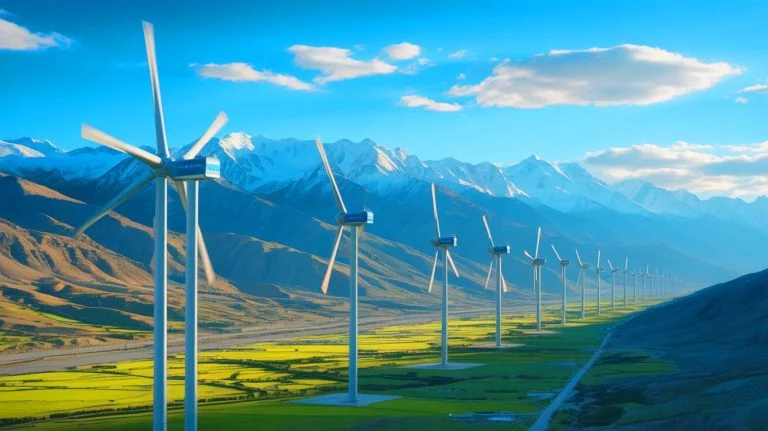| IN A NUTSHELL |
|
Perched at an astounding 15,000 feet above sea level, a monumental wind farm in Tibet has begun harnessing the power of the wind to fuel the future. This incredible project, boasting a capacity of 100 megawatts, is set to supply clean energy to 230,000 residents of Nagpu in Tibet. Beyond its immediate impact, the wind farm serves as a cutting-edge research and development hub, pushing the boundaries of what’s possible in renewable energy. This article delves into the intricacies of this groundbreaking initiative, exploring how it stands as a beacon of innovation and sustainability in one of the most challenging environments on Earth.
The Largest High-Altitude Wind Farm
Situated on what is often called the “Roof of the World,” this massive wind farm is now recognized as the largest of its kind located at ultra-high altitudes. With 25 turbines installed at 15,255 feet, the facility has begun generating electricity for the residents of Nagqu, Tibet. The project is spearheaded by the China Energy Investment Corporation, a key player in renewable energy advancements. The 100-megawatt facility is engineered to produce approximately 200 million kWh of electricity annually. This substantial output is not just a triumph of engineering; it represents a significant step forward in reducing carbon emissions, estimated to cut down carbon dioxide by about 160,000 tons each year.
Such a reduction in emissions underscores the potential of renewable energy in combating climate change. With global temperatures on the rise, initiatives like this one reveal the promise of harnessing natural resources in innovative ways to meet energy demands sustainably.
Innovative Technology in Extreme Conditions
The wind farm in Tibet serves a dual purpose: generating energy and acting as a laboratory for testing advanced technologies in extreme conditions. Located at such high altitudes, the turbines face challenges including vast temperature fluctuations, intense ultraviolet radiation, and harsh weather conditions like wind, snow, rain, and sand. These elements contribute to the erosion of turbine blades. To combat this, China Energy has developed a specialized paint to protect the most exposed parts of the turbines.
In addition, the blades have been extended to enhance efficiency under low atmospheric pressure, a necessity given the unique environment. The entire installation spans an area of over 34 acres, showcasing a blend of innovation and resilience. These technological adaptations not only ensure the longevity and efficiency of the wind farm but also provide invaluable data for future projects in similar terrains.
Impact on Local Communities
The wind farm is more than just an energy project; it is a transformative force for the local communities in Nagpu. By providing reliable and sustainable electricity, it empowers residents and contributes to the region’s economic development. Access to renewable energy resources reduces dependency on non-renewable energy sources, ultimately leading to a more sustainable lifestyle.
Moreover, the project generates employment opportunities, from the construction phase to ongoing maintenance and research positions. This boost in employment not only enhances the local economy but also provides educational opportunities for residents to gain skills in the renewable energy sector. The wind farm stands as a testament to how large-scale renewable projects can deliver tangible benefits to local populations, fostering both environmental and social progress.
Future Prospects in Renewable Energy
This ambitious project in Tibet highlights the potential for expanding renewable energy in challenging environments worldwide. The success of such a high-altitude wind farm opens the door for similar initiatives in other mountainous regions, which often remain untapped due to logistical and environmental challenges. The knowledge gained from operating in such conditions is invaluable, providing a blueprint for future developments.
Furthermore, the project underscores the importance of international collaboration and innovation in tackling global energy challenges. As countries strive to meet climate goals and reduce carbon footprints, the lessons from this wind farm could inform policy and inspire new energy projects. Renewable energy, once seen as a supplementary power source, is steadily becoming a cornerstone of global energy strategies.
As the world continues to grapple with climate change, projects like the Tibet wind farm might just be the key to a sustainable energy future. How will other nations leverage such pioneering efforts to transform their energy landscapes, and what role will they play in the global shift toward renewables?
Did you like it? 4.6/5 (24)







Wow, 15,000 feet! How do they even get the equipment up there? 😲
This is impressive! But how do they maintain the turbines in such harsh conditions?
Great initiative! I hope more countries follow this example.
Does this mean we can expect more wind farms in other high-altitude areas?
Isn’t it risky to have such large structures where weather is so unpredictable?
The specialized paint sounds interesting. How does it work exactly?
How does the local community benefit from this, apart from electricity?
What happens if the wind stops blowing? Do they have backup power?
I’m curious about the extended blades. How much extra power do they generate?
This is a great step towards sustainability! Go, Tibet! 🌍💚